Martial Eagle
- December 18, 2023
- 0 comment
The Martial Eagle (Polemaetus bellicosus) is a large eagle native to sub-Saharan Africa. It is the only member of the genus Polemaetus. A species of the booted eagle subfamily (Aquillinae), it has feathering over its tarsus. One of the largest and most powerful species of booted eagle, it is a fairly opportunistic predator that varies it prey selection between mammals, birds and reptiles.
Physical Appearance

Martial Eagle
- Lifespan: 15 to 20 years
- Habitat: Lowland Podocarp and Hardwood Forests
- Diet: Omnivores, Insects, Worms, and Spiders.
- Size: 40 to 45 cm
- Weight: 1.2 to 1.8 kilograms
- Wingspan: measuring only a few centimeters.
- Conservation Status: Critically Endangered
- Population Trend: Stabilize Population
Its hunting technique is unique as it is one of few eagle species known to hunt primarily from a high soar, by stooping on its quarry. An inhabitant of wooded belts of otherwise open savanna, this species has shown a precipitous decline in the last few centuries due to a variety of factors.
Species Type of Martial Eagle
The Martial Eagle (Polemaetus bellicosus) is a large and powerful eagle species native to sub-Saharan Africa. It is one of the largest eagles in Africa and is known for its impressive size, strength, and predatory prowess. The Martial Eagle is a member of the Accipitridae family and is characterized by its dark brown plumage, strong build, and distinctive white markings on the wings and legs. These eagles are formidable hunters, preying on a variety of mammals and birds, and they are often found in open savannah and wooded areas where they can spot and pursue their prey.
- Kingdom: Animalia
- Phylum: Chordata
- Class: Aves
- Order: Accipitriformes (birds of prey)
- Family: Accipitridae (hawks, eagles, kites)
- Subfamily: Buteoninae (booted eagles)
- Genus: Polemaetus (monotypic genus, only one species)
- Species: Polemaetus bellicosus (Martial Eagle)
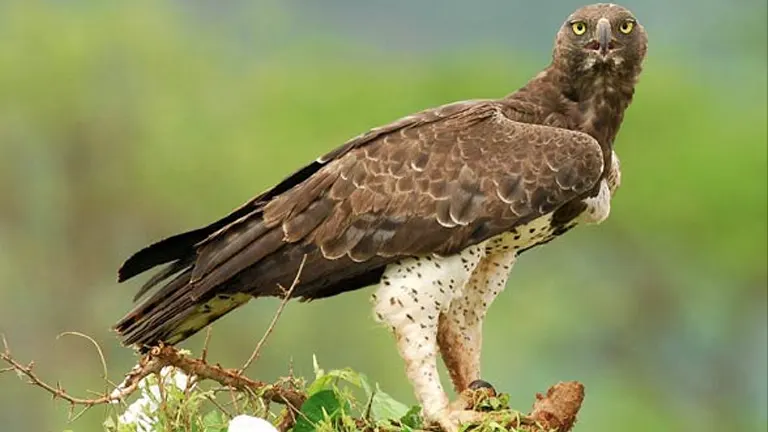

The martial eagle is one of the most persecuted bird species in the world. Due to its habit of taking livestock and regionally valuable game, local farmers and game wardens frequently seek to eliminate martial eagles, although the effect of eagles on this prey is almost certainly considerably exaggerated.
Feather Coloration of Martial Eagle
The Martial Eagle (Polemaetus bellicosus) is characterized by its distinctive feather coloration. The plumage of the Martial Eagle is generally dark brown, with variations in shades that can include a mix of dark and lighter brown tones. The upperparts, including the back and wings, tend to be dark brown, while the underparts may have a lighter brown or tawny color.
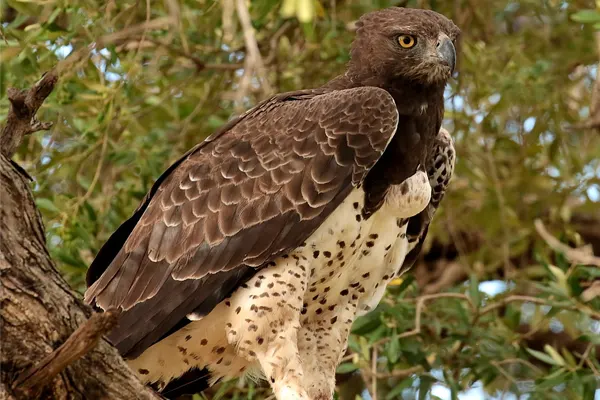
Male
- Head and neck: Black, sometimes with a faint white collar or streaks on the nape.
- Back and wings: Deep brown with a slight sheen, sometimes appearing almost black in certain lighting.
- Underparts: Tawny or chestnut brown, often lighter on the chest and belly.
- Tail: Black with a broad white band at the base and a narrower white tip.
Female
- Head and neck: Dark brown, sometimes with faint white streaks or mottling on the cheeks and nape. This area is generally lighter than the male’s black head and neck.
- Back and wings: Deeper brown compared to males, often with a more pronounced rufous or chestnut hue, particularly on the wing coverts.
- Underparts: Tawny or chestnut brown, similar to males, but often with darker streaks or barring on the belly and legs.
- Tail: Similar to males, with a black base, a broad white band,
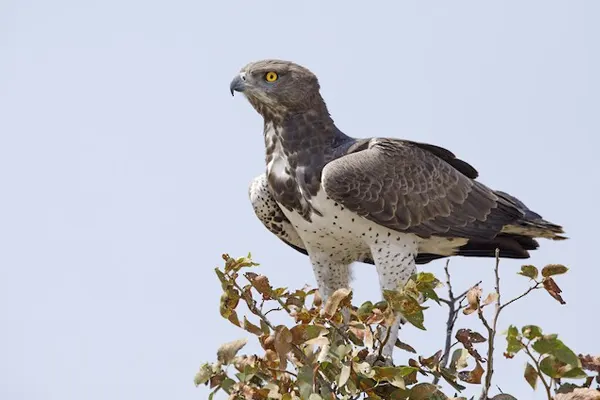
One of the notable features of the Martial Eagle’s plumage is the presence of white markings. These white markings are typically found on the leading edge of the wings, forming a distinctive pattern known as “windows” or “panels.” These white panels are visible when the eagle is in flight and contribute to its recognizable appearance.
Flight Characteristics of Martial Eagle
The Martial Eagle’s flight characteristics are a testament to its adaptation as a supreme aerial hunter. Their wings, maneuverability, and diverse flight styles allow them to dominate the open skies and secure their place as apex predators in their ecosystems.
- Broad, long wings: With wingspans reaching up to 7.5 feet, these wings provide ample lift for soaring and gliding effortlessly over vast distances.
- Rounded wingtips: The rounded tips offer stability and maneuverability, allowing for tight turns and quick changes in direction when hunting.
- Variable wing position: Martial eagles adjust their wing angle and camber depending on the situation. They can flatten their wings for efficient high-altitude soaring, and tilt them slightly upwards for steeper climbs or tighter turns.
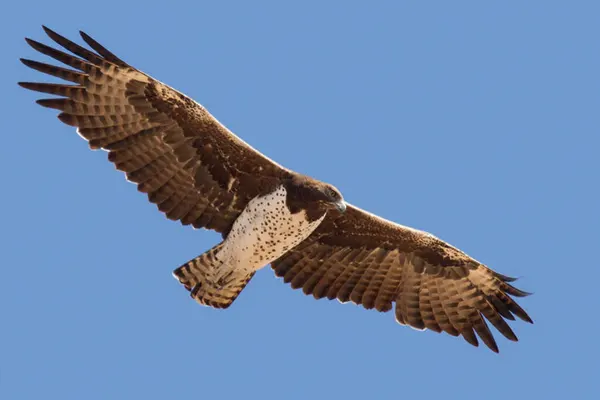
- Soaring: Martial eagles spend most of their time soaring at incredible heights, sometimes reaching 3,000 feet or more. This allows them to scan a large area for prey and conserve energy while maintaining a commanding view.
- Diving: When spotting prey, they can switch from soaring to a powerful, controlled dive, reaching speeds of up to 150 miles per hour. Their streamlined body and sharp claws ensure a successful capture.
- Hovering: In some situations, they may hover briefly using their large wings to maintain position over prey or a potential nest site.
The flight characteristics of the Martial Eagle reflect its role as an apex predator, combining strength, agility, and soaring abilities to cover vast territories and efficiently hunt for prey in its sub-Saharan African habitat.
Migration Patterns of Martial Eagle
Martial Eagle migration patterns are dynamic and influenced by various environmental factors. While some populations remain sedentary, others undertake partial migrations to secure resources and ensure their survival. Further research using advanced tracking methods is crucial to fully understand the intricate movements of these majestic birds.
Sedentary Populations
- Large portions of the Martial Eagle population remain in their breeding territories year-round, particularly in areas with consistent food availability and favorable climate.
- Juveniles may disperse some distance from their natal territory in search of new home ranges, but this typically doesn’t involve long-distance migrations.

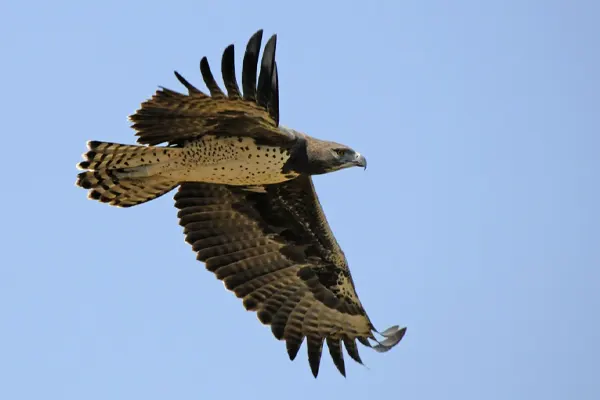

Migratory Populations
- Some populations, especially those inhabiting drier regions with seasonal fluctuations in prey availability, undertake partial migrations.
- This typically involves movement to more favorable areas during the dry season, often towards areas with higher rainfall and more abundant prey.
- These migrations are not extensive, usually covering distances of a few hundred kilometers.
Martial Eagles don’t exhibit typical migration patterns, it’s essential to note that their movements within their home range can be influenced by factors such as food availability, breeding requirements, and environmental conditions. For example, they may adjust their locations based on the seasonal abundance of prey or to find suitable nesting sites.
Habitat & Distribution of Martial Eagle
The Martial Eagle is a versatile bird that occupies a range of habitats across sub-Saharan Africa, adapting to different ecosystems and altitudes within its geographical distribution. Their ability to thrive in varied landscapes contributes to their widespread presence in the region.
- Open habitats: Martial eagles favor open landscapes with scattered trees and minimal vegetation density. These habitats include:
- Savannas: Wooded savannas with acacia trees and grasslands offer ample hunting opportunities.
- Steppe and semidesert: In drier regions, they can adapt to scrublands and open plains with isolated trees.
- Bushy woodlands: Areas with thornbush and rocky outcrops provide nesting sites and vantage points.

Distribution
- Sub-Saharan Africa: The Martial Eagle boasts a vast distribution across most of sub-Saharan Africa, excluding dense forests.
- Range: They are found in over 40 countries, with strongholds in countries like Botswana, Namibia, South Africa, and Zimbabwe.
- Elevation: While primarily found at lower altitudes, they can adapt to varied elevations, reaching up to 3,000 meters in some areas.
The Martial Eagle’s adaptability and preference for open habitats with scattered trees have allowed them to thrive across a vast and diverse range in sub-Saharan Africa. Understanding their habitat preferences is essential for conservation efforts aimed at protecting these magnificent birds.
Behavioral Traits of Martial Eagle
The behavioral traits of the Martial Eagle reflect its adaptation to a predatory lifestyle, emphasizing solitary behavior, territoriality, and sophisticated hunting strategies. These traits contribute to the success of the species as a top predator in its ecosystem.
Solitary and Territorial
- Martial eagles are fiercely independent and rarely tolerate others of their kind in their established territory. They maintain vast home ranges, sometimes exceeding 100 square kilometers, and fiercely defend them from intruding eagles.
- Outside the breeding season, they lead solitary lives, spending their days soaring high above the savanna in search of prey.
- As apex predators, Martial eagles possess an impressive hunting prowess. They rely on their keen eyesight and powerful talons to capture a diverse range of prey, including small mammals, reptiles, and even birds of prey smaller than themselves.
- Their hunting strategies are diverse and adaptable. They may perch on tall trees to scan for prey, soar high for a surprise dive attack, or even flush prey out of hiding by stomping on the ground.
- They possess incredible strength and agility, capable of carrying prey twice their own weight during flight.
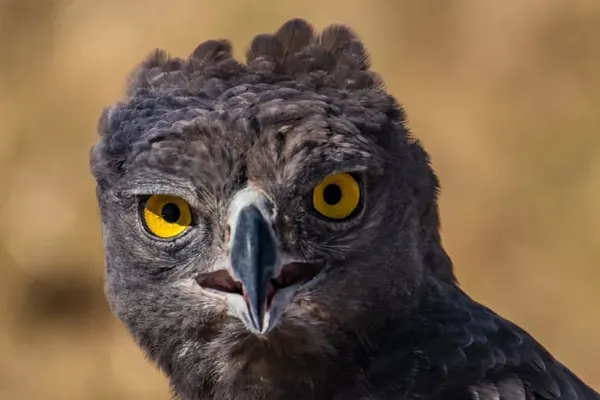
Dutiful Parents
- During the breeding season, Martial eagles form strong pair bonds and remain faithful to each other for life. They collaborate in building a large stick nest in tall trees, often reusing the same nest for multiple years.
- Both parents share the responsibility of raising their chicks, providing food, and protecting them from predators. They are fiercely protective of their offspring and will boldly confront much larger animals to ensure their safety.
The Martial Eagle’s behavioral traits paint a picture of a powerful, intelligent, and adaptable predator with strong family bonds and a vital role in the African savanna. Understanding their behavior is essential for effective conservation efforts and ensuring their continued reign as the undisputed kings of the skies.
Role in Ecosystem of Martial Eagle
The Martial Eagle’s role in the ecosystem encompasses predator-prey dynamics, population control, and contributions to nutrient cycling. As an apex predator, it plays a vital part in maintaining the balance and health of the ecosystems it inhabits in sub-Saharan Africa.
- Apex Predator: As one of the largest and most powerful eagles in Africa, the Martial Eagle holds a position at the top of the food chain in its habitat. As an apex predator, it helps regulate the populations of various prey species, preventing overpopulation of certain animals that could have negative effects on the ecosystem.
- Population Control: The Martial Eagle preys on a variety of mammals and birds, including small to medium-sized ungulates, rodents, and birds of different sizes. By controlling the populations of these prey species, the eagle helps maintain the balance of the ecosystem and prevents the overgrazing or overpopulation of certain species that could lead to ecological imbalances.
- Scavenging: In addition to hunting, Martial Eagles are known to scavenge on carrion, feeding on the remains of larger animals. This scavenging behavior contributes to the decomposition of carcasses, recycling nutrients back into the ecosystem.
- Territorial Defense: The territorial behavior of Martial Eagles serves not only to establish breeding and hunting grounds but also to defend these territories from potential competitors. This defense helps maintain the stability and integrity of the local ecosystem.
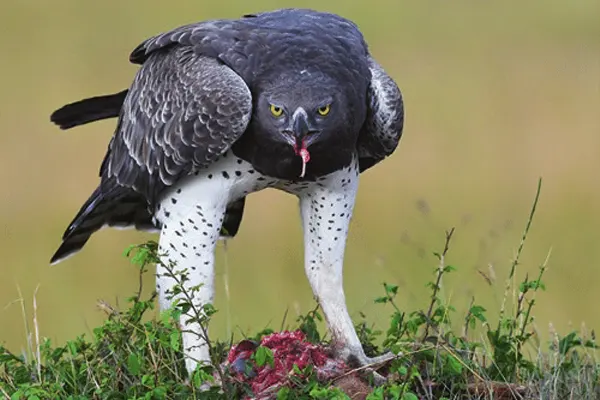
Indicator Species
- The presence and health of Martial eagle populations can serve as an indicator of the overall health of the ecosystem they inhabit. Their sensitivity to environmental changes and dependence on healthy prey populations make them valuable barometers for the ecological well-being of the savanna.
- By monitoring Martial eagle populations, conservationists can gain valuable insights into the broader health of the ecosystem and identify potential threats before they escalate.
The Martial Eagle’s role in the ecosystem transcends its predatory nature. Its presence influences the food web, promotes plant dispersal, acts as an indicator species, and holds cultural significance, making it a vital component of the African savanna’s health and well-being. Protecting these majestic birds is not just about protecting a species but about safeguarding the delicate balance of an entire ecosystem.
Dietary Habits of Martial Eagle
The dietary habits of the Martial Eagle are characterized by a diverse range of prey, a combination of hunting and scavenging, and an ability to handle relatively large prey. These habits contribute to the ecological role of the Martial Eagle as a top predator in its habitat.
- Varied Prey: Martial Eagles have a broad diet that includes a wide variety of prey species. They are known to hunt mammals of different sizes, ranging from small rodents and hares to medium-sized ungulates like dik-diks and small antelopes. Birds, reptiles, and occasionally larger mammals such as monkeys or monitor lizards may also be part of their diet.
- Hunting Strategy: These eagles are skilled hunters that use a combination of soaring and high-speed dives to catch their prey. They often perch on high vantage points, such as trees or cliffs, to survey the surrounding landscape. Once prey is spotted, they swoop down with great speed and accuracy to make a capture using their powerful talons.
- Large Prey Handling: Martial Eagles are known to take on relatively large prey compared to their own size. They have powerful talons and a strong beak, enabling them to tackle and handle prey that may be close to their own size or even slightly larger.
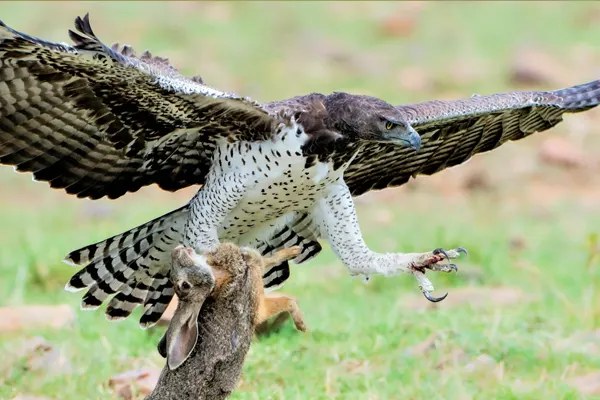

- Carrion Consumption: In addition to hunting, Martial Eagles are opportunistic scavengers and may feed on carrion. They are known to exploit the remains of larger animals, benefiting from the scavenging behavior to supplement their diet.
- Territorial Hunting: Martial Eagles establish and defend territories that provide a consistent supply of prey. Their territorial behavior ensures a stable environment for hunting and breeding, reducing competition with other individuals of the same species.
- Impact on Prey Populations: As apex predators, Martial Eagles help regulate the populations of their prey species. This has a cascading effect on the entire ecosystem by preventing overpopulation of certain species and maintaining a balance in the food web.
- Feeding Young: During the breeding season, when raising chicks, the diet of Martial Eagles may shift to include more frequent hunting to meet the increased energy demands of feeding their young.
The Martial Eagle’s dietary habits are a testament to its adaptability and dominance as a top predator. Its diverse menu, opportunistic nature, and impressive hunting techniques ensure its success in the African savanna.
Interesting Facts of Martial Eagle
The Martial Eagle is one of the largest eagles in Africa, with a wingspan that can reach up to 2.6 meters (8.5 feet). Adult females are typically larger than males. Adult Martial Eagles have dark brown plumage on their upperparts and a lighter, tawny color on their underparts. They are characterized by prominent white markings on the leading edge of their wings, visible during flight.
- Powerful Predator: As an apex predator, the Martial Eagle is known for its strength and hunting prowess. It preys on a wide range of animals, including mammals, birds, and occasionally reptiles, with a particular preference for medium-sized mammals.
- Territorial Behavior: Martial Eagles are territorial birds, and they establish and defend large territories that can span many square kilometers. These territories are crucial for securing a stable supply of prey and suitable nesting sites.
- Elaborate Courtship Displays: During the breeding season, Martial Eagles engage in elaborate courtship displays. These displays involve aerial acrobatics, calling, and mutual soaring. Successful pairs form strong bonds that last beyond the breeding season.
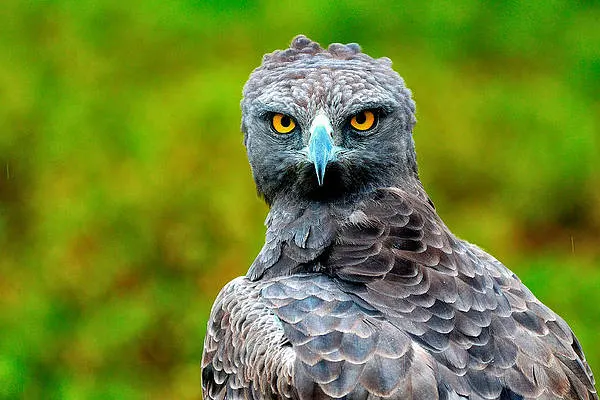
- High-flying Soarers: Martial Eagles are skilled soarers and can reach impressive altitudes by utilizing thermal updrafts. This soaring ability is advantageous for spotting prey over vast distances.
- Long Lifespan: In the wild, Martial Eagles can live up to 14-20 years, contributing to their longevity compared to some other raptor species.
- Conservation Status: While not currently listed as globally threatened, Martial Eagles face threats such as habitat loss, persecution, and collision with power lines. These factors make conservation efforts important to ensure their continued survival.
These majestic birds are not only impressive predators but also play a vital role in the health of the African savanna ecosystem. Their intelligence, adaptability, and strength make them truly awe-inspiring creatures.
Nesting Habits of Martial Eagle
The Martial Eagle’s nesting habits are a testament to their dedication to family, their resourcefulness, and their adaptations to a changing environment. These majestic birds invest heavily in their offspring, ensuring their survival and contributing to the continuation of their lineage in the African savanna.
- Nest Construction: Martial Eagles construct large and sturdy nests made primarily of sticks, branches, and other plant materials. These nests are often bulky and can reach substantial sizes, especially as the eagles reuse and add to them over successive breeding seasons.
- Nesting Sites: Martial Eagles select elevated and strategic locations for their nests. Common nesting sites include cliffs, large trees, or other elevated platforms that provide a clear vantage point for monitoring the surroundings. The choice of nesting sites is crucial for the safety of the eggs and chicks and offers a strategic advantage for hunting.
- Territorial Nesting: The eagles are territorial during the breeding season, and the establishment of a nesting territory is a critical aspect of their reproductive behavior. The size of the territory depends on factors such as food availability and the local environment.
- Breeding Season: Martial Eagles typically breed during certain seasons, with variations depending on the specific region. Courtship displays, involving aerial acrobatics and vocalizations, precede the breeding season. Successful pairs form strong bonds, and the female usually lays one or two eggs.
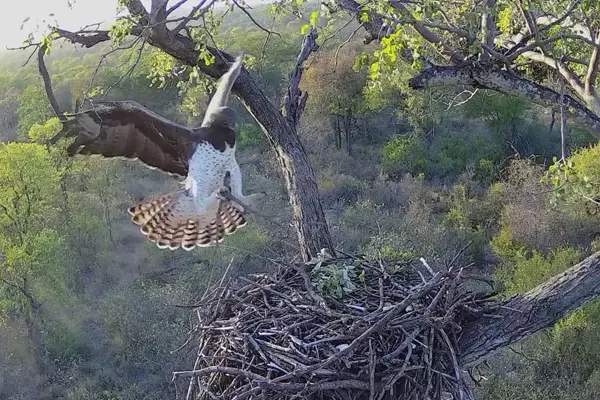
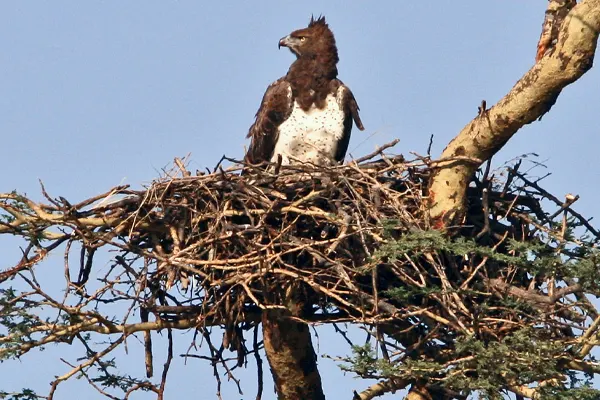
- Incubation and Parental Care: Both the male and female are involved in incubating the eggs, which lasts for about 45 to 53 days. After hatching, the chicks are cared for by both parents. The young eagles remain in the nest for several months, with the parents providing food and protection until they fledge.
- Protection of the Nest: Martial Eagles are known to fiercely defend their nests against potential threats, including other raptors or large birds. The eagles may use their talons and beak to deter intruders and protect their offspring.
- Reusing Nests: Martial Eagles often reuse their nests for multiple breeding seasons. Over time, the nests can grow in size as the eagles continue to add new materials. This behavior is a practical adaptation, saving time and energy during subsequent breeding attempts.
The nesting habits of the Martial Eagle provides insights into their reproductive strategy and the importance of secure and elevated locations for successful breeding and chick rearing.
Calls & Vocalizations of Martial Eagle
The Martial Eagle’s calls and vocalizations offers valuable insights into their behavior, social interactions, and ecological roles. These vocalizations contribute to their success as apex predators and play a crucial part in their survival and communication within the African savanna ecosystem.
Main Calls
- High-pitched scream: This piercing, shrill scream is the most common call, often used in territorial defense, during courtship displays, and when calling for their mate. It can be heard from several kilometers away and carries a sense of power and intimidation.
- Deep, booming call: This lower-pitched, resonating call is typically used during pair bonding and courtship displays. It’s a more melodic and drawn-out sound compared to the scream and suggests cooperation and closeness between the birds.
- Begging call: A high-pitched, whiny call used by juveniles to solicit food from their parents. It’s a more persistent and insistent sound compared to other calls and serves to ensure their needs are met.
- Chattering: A series of rapid, high-pitched chirps used in various contexts, including during interactions with other eagles, when chasing prey, or even during aggressive displays.
- Whistling: A short, clear whistle, often used during flight or when perched. The purpose of this call is not fully understood, but it might be related to communication or orientation within the territory.
- Silent flight: Interestingly, Martial Eagles have feathers with a special structure that minimizes noise during flight, allowing them to approach prey undetected. This silent feature complements their vocalizations for different communication needs.
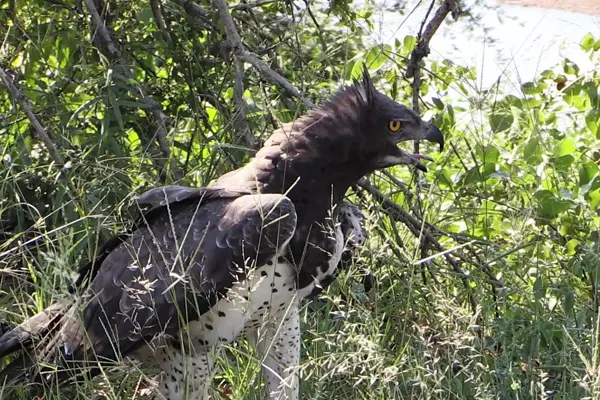
Functions of Calls
- Territorial defense: Vocalizations play a crucial role in defending their vast territories against intruding eagles. The high-pitched scream serves as a strong warning and intimidation signal.
- Courtship and pair bonding: Deep calls and chattering are used to attract mates, strengthen pair bonds, and coordinate breeding activities.
- Communication with young: Begging calls ensure the chick’s needs are met, while other vocalizations might guide them or warn them of potential dangers.
- Information sharing: Calls can also communicate information about prey availability, predator presence, or other important environmental cues to other eagles.
The vocalizations of the Martial Eagle is essential for researchers and enthusiasts to interpret their behavior, breeding activities, and interactions within their social structure. The distinctiveness of their calls also contributes to the eagles’ presence and recognition in their native habitats.
Conservation Status of Martial Eagle
The future of the Martial Eagle remains uncertain, but with continued and intensified conservation efforts, there is hope for their recovery. Addressing the major threats, promoting sustainable practices, and engaging local communities are crucial to ensuring their survival and continued reign as apex predators in the African savanna.
Threats and Challenges
- Habitat Loss: The primary threat to Martial Eagles is the loss and fragmentation of their savanna habitat due to agricultural expansion, infrastructure development, and deforestation. This reduces their breeding grounds and limits their access to prey.
- Poisoning: Accidental poisoning from agricultural pesticides and intentional poisoning from livestock farmers remain a significant threat, leading to direct mortality and reproductive problems.
- Collisions with Power Lines: Electrocution from power lines is a growing threat in areas where eagles utilize them for nesting or perching.
- Disturbance and Persecution: Human activities like hunting, illegal logging, and disturbance near nests can further stress the birds and impact their breeding success.
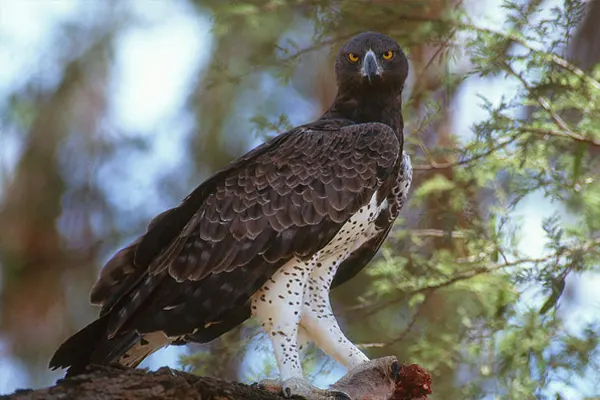
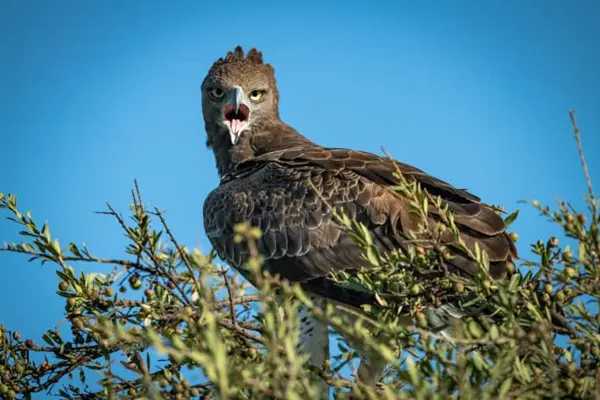
Conservation Efforts
- Habitat protection: Establishing protected areas and corridors, promoting sustainable land-use practices, and restoring degraded habitats are crucial steps in safeguarding their critical habitat.
- Awareness and education: Raising awareness about the Martial Eagle’s plight and the threats they face among local communities and stakeholders is key to garnering support for conservation initiatives.
- Research and monitoring: Ongoing research on their ecology, population trends, and threats informs effective conservation strategies and helps track the success of implemented measures.
- Captive breeding programs: While not a long-term solution, captive breeding programs can play a role in population recovery efforts and provide opportunities for education and research.
Conservation measures include habitat protection, community education to reduce human-wildlife conflicts, and the implementation of measures to mitigate the impact of infrastructure on the species. Monitoring and research programs are also essential for understanding population trends and identifying effective conservation strategies.
Research and Ongoing Studies of Martial Eagle
The research and ongoing studies on the Martial Eagle represent a critical step in ensuring its survival and safeguarding the health of the African savanna ecosystem. By understanding its ecology, threats, and potential interventions, we can develop effective conservation strategies and work towards a future where these majestic birds continue to soar across the skies of Africa.
- Breeding Ecology: Researchers study the breeding behavior of Martial Eagles, including nest site selection, courtship displays, incubation, and chick-rearing strategies. Understanding the factors influencing reproductive success is crucial for conservation efforts.
- Movement and Home Range: Studies use tracking devices such as satellite transmitters or GPS tags to monitor the movement patterns and home range of Martial Eagles. This research helps identify important habitats, migration routes (if any), and potential threats related to their movements.
- Feeding Ecology: Research focuses on the dietary habits and hunting behavior of Martial Eagles. This includes analyses of prey preferences, foraging strategies, and the impact of environmental factors on their hunting success.
- Population Dynamics: Population studies aim to estimate population sizes, monitor trends, and assess factors influencing population dynamics. This information is vital for determining the conservation status of the species and identifying potential threats.

- Human-Wildlife Conflict: Research explores instances of human-wildlife conflict involving Martial Eagles. Understanding the reasons for conflicts, such as predation on livestock or perceived threats to game animals, helps develop strategies for mitigating these conflicts.
- Conservation Genetics: Genetic studies can provide insights into the genetic diversity, population structure, and connectivity of Martial Eagle populations. This information is valuable for developing effective conservation strategies and identifying distinct populations.
- Impact of Infrastructure: Research assesses the impact of infrastructure, such as power lines and wind farms, on Martial Eagle populations. This includes evaluating collision risks, implementing mitigation measures, and understanding the broader implications for the species.
Ongoing research is essential for informing conservation strategies, developing management plans, and addressing the specific threats faced by Martial Eagles across their range. Conservation organizations, governmental agencies, and researchers collaborate to gather data, implement conservation measures, and advocate for the protection of these magnificent birds.
Educational and Ecotourism of Martial Eagle
Educational and ecotourism initiatives related to the Martial Eagle (Polemaetus bellicosus) can play a crucial role in raising awareness about these magnificent birds, promoting conservation, and fostering a deeper understanding of the ecosystems they inhabit.
- Guided Bird Watching Tours: Organized bird watching tours in areas where Martial Eagles are found can provide enthusiasts and nature lovers with the opportunity to observe these eagles in their natural habitat. Knowledgeable guides can offer insights into their behavior, ecology, and the importance of their conservation.
- Educational Workshops and Seminars: Workshops and seminars focusing on Martial Eagles can be organized for schools, local communities, and interested individuals. These sessions can cover topics such as eagle biology, their role in ecosystems, conservation challenges, and how communities can contribute to their protection.
- Nature Interpretation Centers: Establishing nature interpretation centers near Martial Eagle habitats can offer visitors information about the species, their ecology, and the broader ecosystem. Interactive exhibits, educational displays, and multimedia presentations can enhance the learning experience.

- Community Engagement Programs: Involving local communities in educational programs fosters a sense of stewardship and encourages sustainable practices. This can include outreach programs in schools, community events, and initiatives that emphasize the importance of coexisting with wildlife.
- Conservation Workshops: Workshops dedicated to Martial Eagle conservation can bring together researchers, conservationists, and local stakeholders. These workshops can focus on addressing specific threats, developing conservation plans, and fostering collaboration between different stakeholders.
- Photography and Art Safaris: Combining ecotourism with artistic expression, photography and art safaris can attract individuals interested in capturing the beauty of Martial Eagles and the surrounding landscapes. Such activities contribute to promoting appreciation for wildlife and nature conservation.
Combining educational and ecotourism initiatives, stakeholders can contribute to the conservation of Martial Eagles, promote sustainable tourism practices, and inspire a sense of responsibility towards the protection of these iconic birds and their habitats.
Conclusion
The Martial Eagle (Polemaetus bellicosus) stands as a magnificent and influential species within the diverse ecosystems of sub-Saharan Africa. Its impressive size, powerful predatory capabilities, and distinctive behaviors contribute to its ecological significance as an apex predator. However, the species faces challenges that warrant attention and concerted conservation efforts.
The ongoing research endeavors focused on the breeding ecology, movement patterns, and population dynamics of Martial Eagles provide valuable insights for developing effective conservation strategies. Understanding their dietary habits, vocalizations, and nesting behaviors not only enhances our scientific knowledge but also fosters an appreciation for the species among researchers, conservationists, and the general public.
Conservation initiatives, including educational programs and ecotourism activities, play a pivotal role in raising awareness about the importance of Martial Eagles and the ecosystems they inhabit. By engaging local communities, fostering sustainable practices, and promoting responsible tourism, we can contribute to the long-term well-being of these eagles and their habitats.
The current “Vulnerable” status of the Martial Eagle on the IUCN Red List underscores the urgency of conservation actions. Addressing threats such as habitat loss, persecution, and collisions with infrastructure requires collaborative efforts from governments, conservation organizations, communities, and individuals.
In the face of these challenges, ongoing conservation initiatives are making strides in safeguarding the Martial Eagle and its environment. Continued research, education, and sustainable tourism practices are essential components of a holistic approach to ensure the survival and thriving of this iconic species for future generations.
Ultimately, the conservation of the Martial Eagle is not only about preserving a remarkable bird species but also about maintaining the health and balance of the ecosystems it inhabits—an endeavor that reflects our shared responsibility for the biodiversity of our planet.



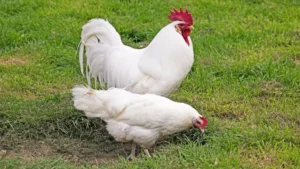
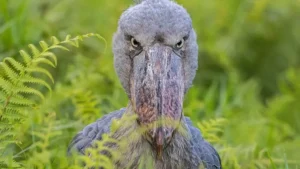
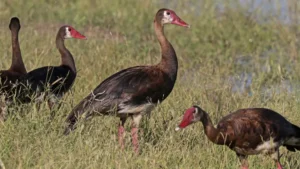

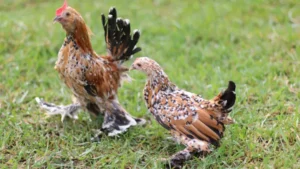
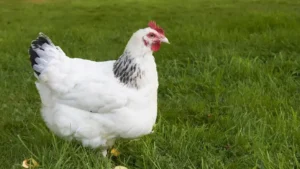
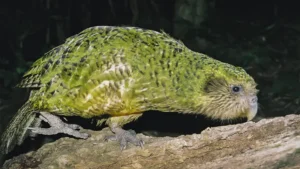



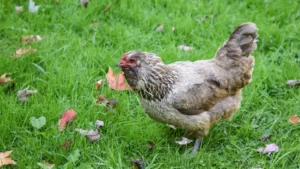
Leave your comment